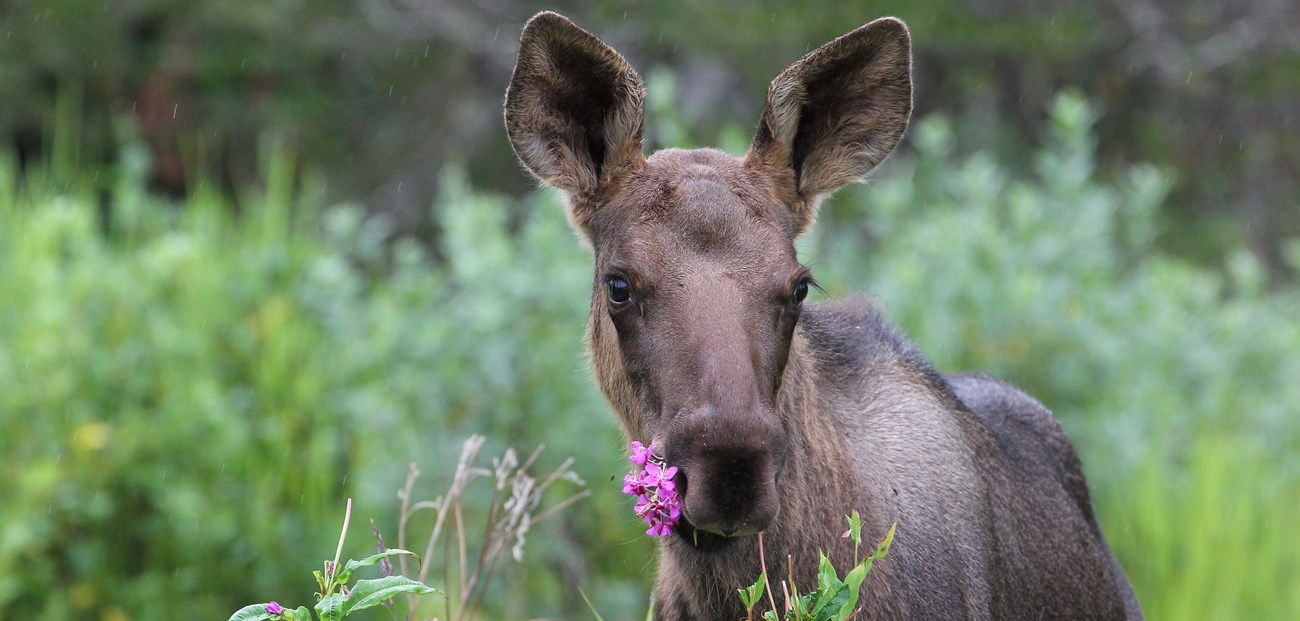
MarchSteller sea lions feed on herring in inshore waters and can be seen around coastal towns, including Juneau. Occasionally, killer whales that follow sea lions into shallow waters may be observed from shore.Chesnut-backed chickadees, winter wrens, Steller's jays, red-breasted nuthatches, golden-crowned kinglets, and other winter resident birds begin courtship singing in March. In late March, listen for the courtship drumming of sooty grouse in forested areas. Herrring move into shallow areas to spawn on kelp beds. Sea ducks begin their northward migrations. Loons, grebes, mergansers, and a variety of sea ducks may be abundant around herring spawning areas. Owls establish nesting territories by hooting and calling during March. Listen for great horned owls calling late in the night. Northern saw-whet, western, screech and great gray owls also call in this season, but are rarely seen. AprilMountain goats move to lower elevations to feed on the first green plants of spring. Look for them on south-facing slopes. Brown and black bears emerge from winter dens. Bears are often visible in avalanche areas on steep mountains slopes. Watch for signs of deer and bears eating emerging skunk cabbage flowers and leaves.Ruby-crowned kinglets arrive and begin singing. Hermit and varied thrushes and American robins appear in large numbers. Lapland longspurs, snow buntings, and golden-crowned sparrows begin moving through Southeast. Eulachon (a small oil-rich fish also known as hooligan) move into rivers to spawn. Spawning herring reach maximum concentrations in sheltered waters. Dolly Varden char being their seaward migration from wintering areas in freshwater lakes. Harbor seals congregate at river mouths during the eulachon run. They can often be seen hauled out on sandbars and icebergs. Sea otter pups may be born any time of year, but most are born in spring. Sea otters occur along the outer coast of Southeast and in Icy Strait. in early April, trumpeter swans, Canada geese, and a variety of dabbing ducks move northward from southern areas. Northern pintails, blue-winged teal, and American wigeons arrive in early April. Blue grouse can be heard hooting in spring courtship. In late April, watch for migrant sea ducks and shorebirds. Barrow's goldeneyes, surf scoters, black turnstones, and surfbirds move through in large numbers. Watch for uncommon migrants, including red-necked grebes, sandhill cranes, red-tailed and rough-legged hawks, and other birds of prey. Late April is a good time to visit the Stikine River Flats near Petersburg. Bald eagles, gulls, and mergansers are attracted to river mouths where eulachon run. Bald eagle may be observed in old-growth forest along the coast and river valleys. MayBears are feeding on newly emerging vegetation. Black bears frequent grassy tidal flats to feed on sedges and intertidal plants. Brown bears may be seen in alpine tundra or on tidal flats during May. Sitka black-tailed deer fawns are born during late May through June. During this period, deer may be seen along forest fringes adjacent to a beach or muskeg.Beaver and muskrat can be observed in early morning and late evening along streams and ponds. Moose begin calving. Cow moose with young may be encountered in muskegs and tall-shrub thickets along rivers and in the Gustavus area. Snowshoe hare litters are born during April and May. Watch for females wtih young in late evening and early morning in tall-shrub thickets of mainland southeast. Tufted puffins, common murres, pigeon guillemots, glacous-winged gulls, and other seabirds begin gathering at nesting colonies on small islands along the outer coast. Seabird colonies are established at North Marble Island at Glacier Bay, at Forester Island near Dixon entrance, and St. Lazaria Island near Sitka. Murres and puffins can be observed at sea along the outer coast and in open passages. Marbled murrelets, pigeon guillemots, and some other alcids can be see in nearshore waters throughout this region. Migrant songbirds arrive and being their courtship songs. Look and listen for ruby-crowned kinglets, commonyellowthroat, yellow-rumped warbler, northern waterthrush, and varied, Swainson's, and hermit thrushes. Steelhead trout move into freshwater streams. Salamanders and boreal toads may be found in muskeg ponds throughout the summer. Inland ponds and lakes are excellent places for birding. Look for Bonaparte's gull, horned grebe, northern pintail, American wigeon, northern shoveler, yellowlegs, and spotted sandpiper. This is the best time of year to look for some southeast Alaska specialties, including warbling and red-eyed vireos, Tennessee warbler, MacGillivray's warbler, American redstart, western tanager, brown-headed cowbird, and band-tailed pigeon. Most of these can be found in riparian forests along the major river systems on the mainland. American crows, common in coastal communities, are vocal and highly territorial during nesting. |
Last updated: December 29, 2023
